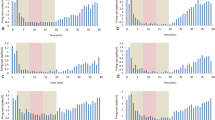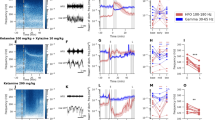Abstract
-
1.
The application of the volatile anaesthetics, halothane and isoflurane (1% v/v and 2% v/v), to the CNS of Lymnaea reduced the firing frequency of the small weakly coupled pedal A cluster (PeA) neurones, which eventually become quiescent. There was no change in their resting membrane potential.
-
2.
Met-enkephalin significantly increased the coupling coefficient between PeA neurones.
-
3.
The volatile anaesthetics decreased the coupling coefficient even in the presence of met-enkephalin.
-
4.
These effects were dose dependent and the effects of halothane were more rapid than those of isoflurane, reflecting their different anaesthetic potencies.
Similar content being viewed by others
References
Ahmed, I. A. (1995) Effect of general anaesthetics and other pharmacological agents on intracellular calcium levels in identified molluscan neurones. Ph.D. Thesis, University of Leeds, UK.
Ahmed, I. A., Winlow, W. (1995) Halothane raises intracellular calcium concentration ([Ca2+]i) in cultured molluscan neurones. J. Physiol. (Lond.) 423, 3P.
Audesirk, G. (1985) Amine-containing neurones in the brain of Lymnaea stagnalis. Distribution and effects of precursors. Comp. Biochem. Physiol. 81A, 359–363.
Baker, P. F., Hodgkin, A. L., Ridgway, E. B. (1971) Two phases of calcium entry during the action potential in giant axons of Loligo. J. Physiol. 208, 80–82.
Benjamin, P. R., Winlow, W. (1981) The distribution of three wide acting synaptic inputs to identified neurones in the isolated brain ofLymnaea stagnalis Comp. Biochem. Physiol. 70A, 293–307.
Beyer, E. C. (1993) Gap junctions. Int. Rev. Cytol. 137C, 1–37.
Bigiani, A., Roper, S. D. (1994) Reduction of electrical coupling between necturus tast receptor cells, a possible role in acid tast. Neurosci. Letters 176, 212–216.
Casey, C., Winlow, W. (1985) Cellular localisation of serotonin by glycoxylic acid condensation in Lymnaea. J. Physiol. (Lond.) 369, 169.
Davies, D. N., Steward, Allott, P. R., Mapleson, W. W. (1972) A comparison of arterial and arterialized venous concentrations of halothane. Br. J. Anaesth. 44, 548–550.
De Mello, W. C. (1994) Gap junctional communication in excitable tissues; the heart as a paradigma. Prog. Biophys. Molec. Biol. 61, 1–35.
Dyakonova, T. L., Moroz, L. L., Winlow, W. (1993) Effect of met-enkephalin on electrical coupling between identified neurones in the pulmonate snailHelix and Lymneae. Comp. Biochem. Physiol. 106C, 93–101.
Furshpan, E. J., Potter, D. D. (1957) Mechanism of nerve impulse transmission at crayfish synapse. Nature 180, 342–343.
Girdlestone, D., Winlow, W. (1987) A relationship between neuronal topography and responses to anaesthetics a Lymnaea. J. Physiol. (Lond.) 386, 33P.
Girdlestone, D., Cruickshank, G. H., Winlow, W. (1989) A system for the application of genetal anaesthetics and other volatile agents to superfused isolated tissue preparation. Comp. Biochem. Physiol. 92C, 35–37.
Kyriakides, M. A., McCrohan, C. R. (1989) Effect of putative neuromodulators on rhythmic buccal motor output in Lymnaea stagnalis. J. Neurobiol 20, 635–650.
Loewenstein, W. R. (1981) Junctional intracellular communication: the cell-to-cell membrane channel. Physiol. Rev. 61, 829–913.
McCrohan, C. R., Benjamin, P. R. (1980) Synaptic relationships of the cerebral giant cells with motoneurones in feeding system of Lymnaea stagnalis. J. Exp. Biol. 85, 169–186.
Qazzaz, M. M., Winlow, W. (1995) Volatile anaesthetics and barbiturates have different actions on the input resistance of an identified molluscan neurone. Br. J. Anaesth. 75, 656–657.
Qazzaz, M. M. (1997) Actions of general anaesthetics on electrical synapse. Ph.D. Thesis, University of Leeds, UK.
Slade, C. T., Mills, J., Winlow, W. (1981) The neuronal organisation of the paired pedal ganglia of Lymnaea stagnalis (L.). Comp. Biochem. Physiol. 69A, 789–803.
Spencer, G. E. (1993) The effects of halothane on peptidergic responces of molluscan neurones. Ph. D. Thesis, University of Leeds, UK.
Spencer, G. E., Winlow, W. (1993) Halothane enhances the responses of molluscan neurones to applied neuropeptides. J. Physiol. 467, 178P.
Spencer, G. E., Syed, N. I., Lukowiak, K., Winlow, W. (1995) Halothane-induced synaptic depression at both in vivo and in vitro reconstructed synapses between identified Lymnaea neurons. J. Neurophysiol. 74, 2604–2613.
Spencer, G. E., Syed, N. I., Lukowiak, K., Winlow, W. (1996) Halothane affects both inhibitory and excitatory synaptic transmission at a single identified molluscan synapse, in vivo and in vitro. Brain Res. 774, 38–48.
Spray, D. C., Bennett, M. V. L. (1985) Physiology and pharmacology of gap junctions. Ann. Rev. Physiol. 47, 281–303.
Syed, N. I. (1988) The neural control of locomotion in Lymnaea. Ph.D. Thesis, University of Leeds, UK.
Syed, N. I., Winlow, W. (1989) Morphology and electrophysiology of neurones innervating the ciliated locomotor epithelium in Lymnaea stagnalis (L.). Comp. Biochem. Physiol. 93A, 633–644.
Terrar, D. A., Victory, J. G. G. (1988) Influence of halothane on electrical coupling in cell pairs isolated from guinea pig ventricle. British J. Pharmacol. 94, 509–514.
Wildering, W. C., Janse, C. (1992) Serotonergic modulation of junctional conductance in an identified pair of neurones in the mollusc Lymnaea stagnalis. Brain Res. 595, 343–352.
Winlow, W., Benjamin, P. R. (1976) Neuronal mapping of the brain of the pond snail Lymnaea stagnalis (L.). In: Salánki, J. (ed.) Neurobiology of invertebrates. Gastropoda Brain. Akadémiai Kiadó, Budapest, pp. 41–59.
Yar, T. (1992) The effects of halothane on cultured Lymnaea neurones. Ph.D. Thesis University of Leeds, UK.
Author information
Authors and Affiliations
Additional information
Dedicated to Professor János Salánki for his 70th birthday.
Rights and permissions
About this article
Cite this article
Qazzaz, M.M., Winlow, W. Effect of volatile anaeshetics on the electrical activity and the coupling coefficient of weakly electrically coupled neurones. BIOLOGIA FUTURA 50, 199–213 (1999). https://doi.org/10.1007/BF03543042
Received:
Accepted:
Published:
Issue Date:
DOI: https://doi.org/10.1007/BF03543042




